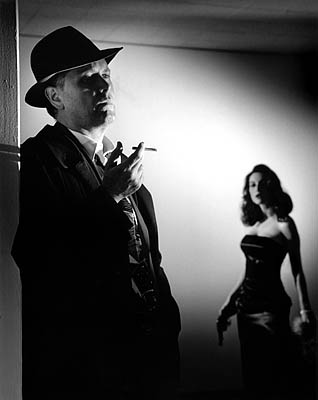 The word noir summons a host of images:
The word noir summons a host of images:
-shadows of venetian blinds splayed across the wall of a dingy office
-a man, his eyes obscured by a fedora, smoking a cigarette in the rain
-a woman leaning over a body in the trembling glow of a street lamp.
But why these?
Like their antecedents in German Expressionism, films considered noir are grouped together in part because they share a similar and distinct visual pattern. The auteur theory long ago enshrined the director as the author of the film medium, but it’s important to remember that classic noir was a style created inside the studio system by a collaborative effort of directors, writers, actors, set designers, costumers, and composers. All of these artists (and more) played vital roles in the development of the noir style. As a photographic style, however, noir was defined primarily by the cinematographer.
The American Society of Cinematographers defines its art as “the authorship of visual images for the cinema, extending from conception and pre-production through post-production to the ultimate presentation of these images.” The cinematographer—most often known on movie sets as the DP, or director of photography—develops and implements a photographic scheme for the film. While the importance of the cinematographer may be publicly undervalued, people in the industry have long known better. Bette Davis called cinematographer Ernest Haller “my miracle man” and worked with him thirteen times. Orson Welles was so grateful to Gregg Toland for his work on Citizen Kane that he shared his title card with the cinematographer, a virtually unheard-of gesture. Alfred Hitchcock, at the height of his power as a director, insisted on working with cinematographer Robert Burks twelve times between 1951 and 1964.
While the cinematographer’s job includes many aspects of photography, it might be most easily understood this way: he or she controls the lights. While reductive, this definition relates nicely to film noir since a crucial element of many noirs is the photographic effect of chiaroscuro, the powerful contrast of light (chiaro) with the elements of darkness and obscurity (oscuro). Unlike most films of the time, noirs favored low-key lighting which accentuated shadows on actors and sets. Noirs are literally dark films, and noir cinematographers tended to be artists who liked working in the dark.
Take the most preeminent noir cinematographer, Hungarian-born John Alton. He is best known for his collaborations with director Anthony Mann on a series of beautiful, brutal films: T-Men (1947), Raw Deal (1947), He Walked By Night (1947), and Border Incident (1949). In total, Alton shot fourteen noirs, including the Joseph H. Lewis masterpiece The Big Combo (1955), the bizarre-but-fascinating Talk About A Stranger (1952), the entertaining police procedural Mystery Street (1950), and the Mike Hammer 3-D slugfest I, the Jury (1953). One thing these disparate films have in common is strikingly high-contrast black and white cinematography. Unlike most cameramen of his time, Alton used very little grayscale, noting, “the most beautiful photography is in a low key with rich blacks.”
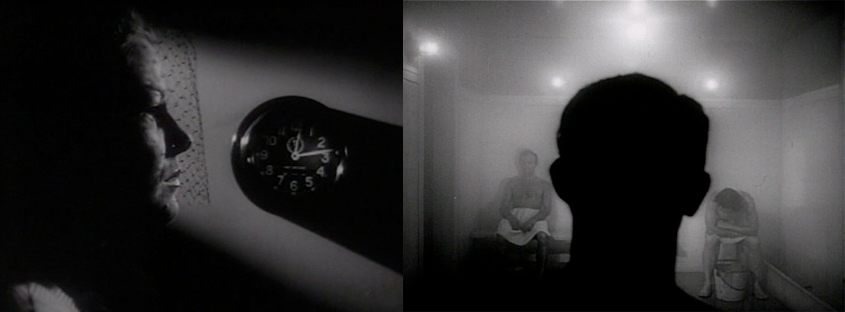
Moreover, Alton worked fast and cheap, since he used a small crew and very few lights to achieve his amazing effects. As the producer Howard Koch once explained, Alton’s unmistakable “black-and-white was so beautiful it was almost like it was painted.”
Some cinematographers helped fashion a house style for their studios. Nicholas Musuraca worked at RKO Pictures from 1927 to 1954 and was instrumental in creating the look of the studio’s prodigious noir output. He did the cinematography for the film generally considered the first noir, Stranger on the Third Floor (1940).
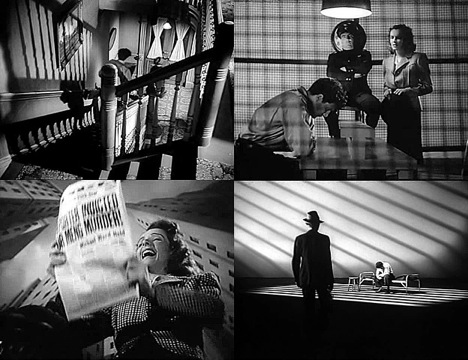
Musuraca also brought his moody lighting to early noirs like The Fallen Sparrow (1943), The Spiral Staircase (1945) and Deadline at Dawn (1946). In 1947, he made his finest film, Out of the Past, a movie by turns romantic and foreboding which many aficionados consider the perfect noir. Later, he supplied mystery and atmosphere to the redbaiter The Woman On Pier 13 (akaI Married a Communist) (1949), John Farrow’s Where Danger Lives (1950), and the unfairly overlooked Roadblock (1951).
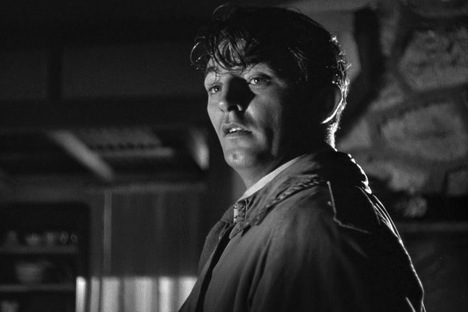
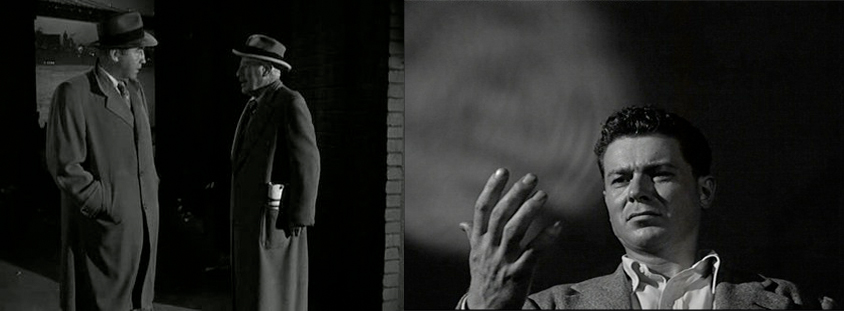
Burnett Guffey’s consistent craftsmanship in these films is impressive, and it’s possible that no single director, writer, producer, actor, or actress signed his or her name to more noirs.
Other major cinematographers during the classic period included John F. Seitz, who shot nine noirs including the Billy Wilder masterpieces Double Indemnity and Sunset Blvd.; Harry Wild, who made eight noirs including the Dick Powell films Cornered, Murder My Sweet, and Pitfall; Joseph LaShelle, whose seven noirs included Otto Preminger’s Laura, Fallen Angel, Where The Sidewalk Ends, and The Thirteenth Letter; and James Wong Howe, who made six noirs including such major entries as Body And Soul, He Ran All The Way, and The Sweet Smell Of Success.
Listed below are sixteen cinmeatographers who shot some 135 film noirs during the classic period. That’s over one third of the entire body of classic noir, including the majority of its masterworks! Here’s where to start appreciating the major, and often undervalued, contribution of these great artists:
- John Alton-T-Men, Raw Deal, The Big Combo
- Burnett Guffey-The Reckless Moment, In A Lonely Place, Scandal Sheet
- Nicholas Musuraca-Stranger On The Third Floor, Out Of The Past, Roadblock
- John F. Seitz-Double Indemnity, The Big Clock, Sunset Blvd.
- Harry J. Wild-Murder My Sweet, Pitfall, Cornered
- Joseph LaShelle-Laura, Fallen Angel, Where The Sidewalk Ends
- James Wong Howe-Body And Soul, He Ran All The Way, The Sweet Smell Of Success
- Milton Krasner-The Woman in the Window, Scarlet Street, The Set-Up
- George Diskant-Desperate, Kansas City Confidential, The Narrow Margin
- Franz F. Planer-Criss Cross, 99 River Street, The Long Wait
- Joseph P. Biroc-Cry Danger, The Killer That Stalked New York, World For Ransom
- Joseph MacDonald-Pickup On South Street, Panic In The Streets, Street With No Name
- Russell Metty-Kiss The Blood Off My Hands, Ride The Pink Horse, Touch Of Evil
- Ernest Laszlo-M (1951), DOA, Kiss My Deadly
- Lee Garmes-Caught, Nightmare Alley, Detective Story
- Woody Bredell-The Killers, Phantom Lady, The Unsuspected
John Alton: T-Men
John Alton: Raw Deal
Nicholas Musuraca: Deadline at Dawn
Nicholas Musuraca: Out of The Past
Burnett Guffey: In a Lonely Place
Burnett Guffey: Nightfall
Jake Hinkson, The Night Editor

Thanks for this article! Kudos fro the Bette Davis mention.
I am a huge fan of classic cinema particularly noir. I write a lot about noir on my blog and incorporate it into my own screenplays. The use of light and dark in these films is astounding. I especially love James Wong Howe (just watched Sweet Smell of Success on the new Criterion Blu-Ray) and Gregg Toland. Toland’s work on the Bette Davis picture “The Little Foxes” is simply amazing.
Thanks, Angelica! Howe and Toland are beyond praise. Have you seen Toland’s work on John Ford’s “The Long Voyage Home”? It’s stunning, just stunning.
The first noir film that captivated me with its cinematography is Billy Wilder’s Double Indemnity. I’m queueing up my Netflix with the films you highlighted in this post. I also love the point you made about artistic collaborations in some noir greats such as Citizen Kane. These projects, for me, are strong critiques of the fascism of auteur theory.
Marvelous and very thorough article on the subject, Jake. You also, once again, introduced me to some titles I’ll be searching for.
Awesome post. Sunset Blvd. is the best. I never get tired of watching it. Can’t wait to check out some of your other titles. Thanks.
Thanks for the recommendation Jake. I will definitely check out “The Long Voyage Home”!
Would you please tell us the first picture’s source?
Excellent article! The contribution of cinematographers to classic film noir is incalculable!
Thnaks for Shaering it